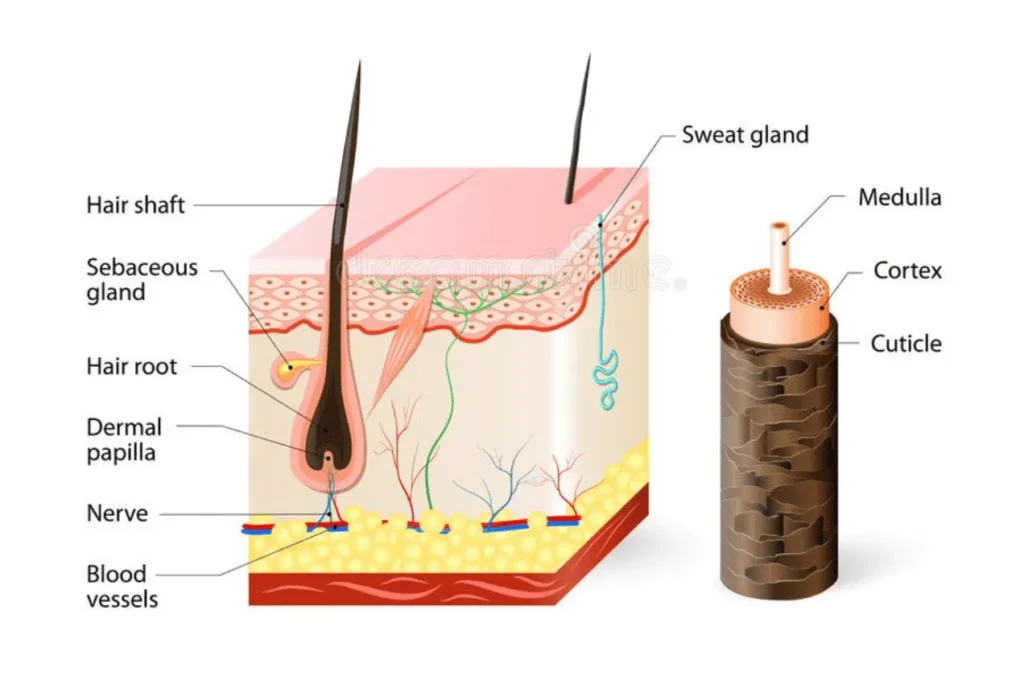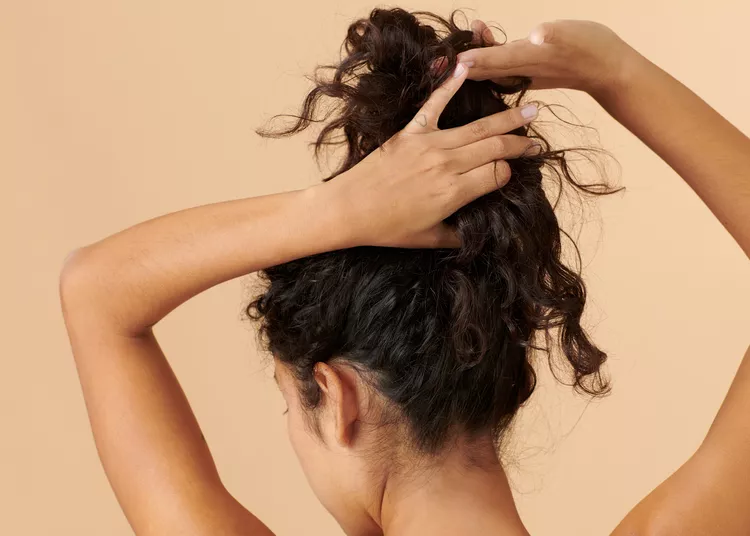Moisture and protein are both essential for healthy hair. A keratin treatment won’t stop this from breaking frequently, and putting on a lot of moisture won’t give it the healthy bounce we usually desire after. Moisture is what gives hair its porosity and flexibility, while protein gives its strength and structure. For the haiir to flourish, both must be in equilibrium. While certain indicators of unhealthy hair, such as breakage, frizz, and brittle ends, can indicate that we need to change our care routine and address the issue, it’s not always obvious where to start. Read on for an explanation of how moisture and protein specifically enable our strands to be healthy and how preserving a balance of both will give
Hair Structure 101

Each hai strand is made up of three layers: the cortex, which is the middle layer, the medulla, which is the deepest layer, and the cuticle, which is the outside layer. The cells that store your DNA are housed in the medulla, while the protein-moisture balance is maintained by the other two layers.
The majority of this shaft is composed of protein and is called the cortex. Disulphide bonds within the cortex hold the protein together, giving its strength and resilience. “The natural shape is determined by these bonds, which also determine the degree of curly or straight hair,” says Valery Joseph, the creator of Valery Joseph care products and salons. According to Joseph, disulphide bonds are the building blocks , and to maintain the finest possible shape for these bonds as well as the texture of your hairr, the proper amount of protein is needed to offer durability and hold everything together.
Moisture enters and exits the plant through the cuticle, the outer layer. It cannot absorb moisture if it is left closed or open. In order to take in and hold onto any moisture, the cuticle must be able to open and close. Because of its capacity to lock in moisture, the cuticle is kept in good condition, protecting the health of the hair from harm.
Signs Your Hair Needs Protein

Our hair strands get weaker and lose their structure when there is not enough protein in them. Dr. Isfahan Chambers Harris, PhD, Medical Scientist, Trichology practitioner, and inventor of Alodia Care, states that “har that lacks protein often looks weak and limp.” “It breaks easily, feels soft and mushy when wet, and lacks a healthy sheen, appearing dull.”
Signs of Protein-Deficient Hair:
Consider the following signs to be an indication that your har isn’t receiving enough protein if you see or feel any of them:
- lifeless and limber look.
- An increase in split ends and breaking.
- Insufficient flexibility.
Common Causes of Protein Deficiency:
Our strands’ protein composition is entirely influenced by our lifestyle and state of health. Joseph says that “Things like sun exposure, chlorine, and heat styling all contribute to protein loss in the hair over time.” Just as Dr. Chambers-Harris notes, pre-existing or predisposed medical disorders like hypothyroidism or hormonal imbalances can also “affect the body’s ability to produce and maintain adequate amounts of protein for healthy hai.”
- Chemical treatments (coloring, bleaching, relaxers).
- Heat styling and overuse of heat exposure.
- Environmental damage (UV rays, chlorinated water).
- Harsh ingredients (sulfates).
- Poor diet or medical conditions.
How to Test for Protein Deficiency:
There’s a pretty easy way to find out if you think your hai may be lacking in protein. Joseph breaks down the process for performing a “stretch test” at home in order to identify a protein deficiency:
- Step 1: Gather a few strands of wet hair between your thumb and forefinger.
- Step 2: Gently tug away from the head.
- Step 3: If the hair has a bit of stretch (before breaking,) this means the har is healthy. On the other hand, if it snaps right away, the har is brittle and lacking protein.
Signs Your Hair Needs Moisture
The reason the hair is dry is that the outer layer is either too open or too firmly closed. The vents located along the cuticle are designed to effortlessly open and close. The appearance of this texture will alter in a few different ways if they don’t.
Signs of Moisture-Deficient Hair:
It’s likely that you’re not receiving enough moisture in your haer if you see or feel any of the following symptoms:
- Rough texture.
- Dull and lifeless appearance.
- Frizziness and tangling.
Common Causes of Moisture Deficiency:
According to Dr. Chambers-Harris, “lots of factors can contribute to moisture deficiency.” “[These can include] dry weather and low humidity, harsh moisture-blocking haer products, frequent use of heat styling tools such as blow dryers, flat irons or curling irons, dehydration from drinking too little water, and certain health conditions.”
- Overuse of heat styling tools.
- Chemical treatments.
- Environmental factors (humidity, sun exposure).
- Dehydration.
- Pre-existing health conditions.
How to Test for Moisture Deficiency:
The porosity of our hair is determined by its capacity to hold onto moisture. There are three levels of porosity: high, medium, and low. Restoring the extremes of that range will take some time and effort. Joseph provides us with some advice on porosity levels as well as a detailed tutorial on how to do a “float test” at home to identify a moisture deficit in the hair:
- Step 1: Take a few strands of clean, detangled and drop them into a bowl or glass of water.
- Step 2: If the hair floats to the top, this means you have low-porosity haer.
- Step 3: If it sinks to the bottom, this is high-porosity. High-porosity hair is typically genetic, but it’s a great test to see how to better care for your hair type.
How to Balance Protein and Moisture
Dr. Chambers-Harris states that “maintaining a proper protein-moisture balance is so important for healthy, resilient hair.” “We need moisture to maintain the softness and flexibility of hair, and protein to reinforce the structure of the haer. There is no greater significance between the two.” Although striking a healthy balance between the two requires careful consideration on an individual basis, our experts have some pointers to provide.
“Incorporate protein and moisture treatments into your rotation by using balancing conditioners that contain both moisture and small amounts of protein,” says Dr. Chambers-Harris. “Most hair types benefit from weekly deep conditioning with moisture-rich products and occasional protein treatments every 3-6 weeks.” If there’s not a weakness in one region of your hair, work on the other. Overcompensation is not necessary. Taking one little step at a time
It’s important to consider your hair’s internal health in addition to the products used to suit its specific requirements. According to Dr. Chambers-Harris, “Haer health starts from within.” “And that includes a healthy diet rich in protein, healthy fats, and vitamins.” The natural ratio of protein to moisture in haer can be preserved to a large extent with a well-balanced diet.
How to Choose The Right Products
There are products out there that can definitely meet your hair’s needs. While using goods high in protein or moisture in moderation can be beneficial, overusing them can also be detrimental. Avoid trying to fix anything if it’s not broken. Our experts have highlighted useful elements to watch out for below.
Protein Heavy Ingredients
There is a wide range of haer protein treatments available on the market. When attempting to restore a protein deficiency, these are the substances you want to look for because of their special abilities, according to Dr. Chambers-Harris.
- Keratin: roughly 90% of the structure of hair is composed of keratin. By topically applying this major protein, one can strengthen the hair shaft, minimise breakage, restore suppleness, and help replace lost protein.
- Hydrolysed Wheat Protein: This component binds to natural proteins to repair hair strength. It strengthens the cuticle’s weak areas and gaps and helps increase moisture retention, smoothness, and volume.”
- Silkworm silk is the source of this protein, which is hydrolysed! It has amino acids called sericin and fibroin that can form bonds with the keratin in hair to aid in the reconstruction of a protective layer.
- Amino Acids: Amino acids strengthen the hair’s resistance to further damage by penetrating the hair shaft and repairing broken protein structures.
- Collagen: The protein present in the scalp and other connective tissues is called collagen. By include this component in your haiir care regimen, you’ll improve the growth-friendly environment for your hair as well as strengthen and suppleness by enveloping each strand in a protective layer.
Moisturizing Ingredients
The following substances are what Dr. Chambers-Harris advises looking for in hair treatments that claim to restore moisture to haiir.
- Hyaluronic acid is a naturally occurring chemical that is present in the skin and connective tissues. It is a great humectant, drawing moisture from the environment into the hair, and has strong water retention characteristics, holding up to 1,000 times its weight in water.
- Aloe Vera: This plant produces a gel-like sap that is high in water, vitamins, minerals, and enzymes that aid in keeping haiir hydrated. This substance is a fantastic natural hydrator that replenishes immediately because it is about 98% water.
- Glycerin: Plant or animal fats are the sources of this organic humectant. To assist retain moisture and avoid deficiency, glycerin draws moisture from the air and binds it to the haiir.
- Honey: Due to its high sugar content, honey is another natural humectant and emollient.
Products Based on Hair Type
You should consider your porosity level in addition to your haiir type when selecting a moisturising product. “Low porosity hair can be moisture deficient as it can have a harder time absorbing hydration,” according to Joseph, “so lightweight moisturising products work best.” According to Joseph, people with highly porous hair—which is often drier and frizzier—should seek for denser products, “like hair oils and leave-in conditioners.”
Valery Joseph Heal Shampoo and Heal Mask are recommended for hair lacking in protein, “to preserve the internal structure of the hair and help repair any damage.” The hair care products in Jospeh’s brand are designed with a unique VJR5 Pro Complex, which incorporates keratin proteins to help rebuild strength.
Conclusion
Haiir elasticity and strength are maintained by the combination of moisture and protein. Before taking any further action, quickly examine your haiir at home to see what’s lacking if you observe any undesirable traits that indicate a lack of moisture or protein. Recall that there are numerous variables at work and multiple approaches to addressing the necessary issues. Overall, the greatest things to do for your hair’s protein-moisture balance are to cut back on excessive heat styling, get regular haiircuts, and eat a nutritious diet.

